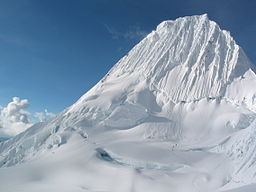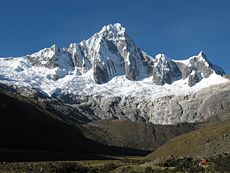- Cordillera Blanca
-
Cordillera Blanca Range Alpamayo (5,947 m)Country Peru Region Ancash Region Part of Andes Highest point Huascarán - elevation 6,768 m (22,205 ft) - coordinates 9°07′17″S 77°36′32″W / 9.12139°S 77.60889°W The Cordillera Blanca (Spanish for "White Range") is a mountain range in the Ancash Region of Peru. Part of the larger Andes range, it includes 33 major peaks over 5,500 metres (18,040 ft) high in an area 21 kilometres (13 mi) wide and 180 kilometres (112 mi) long.
Contents
Overview
The highest mountain in Peru, Huascarán (6,768 m), is located here. Huascarán National Park, established in 1975, encompasses almost the entire range of the Cordillera Blanca.
The 5,947 m (19,511 ft) Alpamayo mountain was declared "World's Most Beautiful Mountain" by an international survey led by former climber Tonni Hiebler in May 1966 in Münich.
Snow melt from the Cordillera Blanca has provided Peru with its year-round water supplies, while 80% of Peru's power comes from hydroelectricity. The area of permanent ice pack shrank by about a third between the 1970s and 2006.[1]
Peaks
There are sixteen 6000m peaks in the Cordillera Blanca with a 400m topographic prominence, and a further seventeen peaks over 5500m.[2] Huascaran Sur, the highest peak, has two commonly quoted heights - 6746m from the Peruvian IGM map, and 6768 from the OEAV survey map.[3]
A selection of the Cordillera Blanca's more famous peaks are listed below.
Mountain Elevation Huascarán Sur 6,768 m (22,200 ft) Huascarán Norte 6,655 m (21,830 ft) Huandoy Norte 6,395 m (20,980 ft) Nevado Huantsan 6,395 m (20,980 ft) Chopicalqui 6,354 m (20,850 ft) Copa 6,188 m (20,300 ft) Hualcan 6,122 m (20,090 ft) Chacraraju 6,112 m (20,050 ft) Artesonraju 5,999 m (19,680 ft) Alpamayo 5,947 m (19,510 ft) Taulliraju 5,830 m (19,130 ft) Nevado Pisco 5,752 m (18,870 ft) Glaciers
The estimated number of glaciers is 260 glaciers of the Cordillera Blanca are very important to life in the valley of the Callejon de Huaylas. They provide water for the irrigation of the puna grasslands and keep the main Santa river drought free year round. They also support the hydroelectric powerstation of Cañón del Pato and form many attractive lagoons. All are over 4000m above sea level, 185 on the western slopes and 75 on the eastern.
As with all Andean glaciers, the Cordillera Blanca has witnessed a major retreat of its during the 20th century due to global climate change. Studies have shown a retreat of over 15% since the 1970s.[4] Some glaciers, such as the Broggi Glacier, have disappeared altogether, with many experts warning that all of the glaciers may be gone within the coming decades.
Lagoons
The Laguna Parón – biggest in the Cordillera Blanca – is considered the most beautiful of all glacial lagoons. Located just north of Huandoy mountain in Caraz, it is a deep turquoise blue.
Other famous lagoons include the green-turquoise Laguna Chinancocha (female lagoon) and Laguna Orconcocha (male lagoons in the Llanganuco valley. Located in the quenoa forests at the foot of Huascarán, they are reachable via a 25 km gravel road off the Callejon de Huaylas highway near the re-built town of Yungay.
Two more beautiful lagoons, the Laguna Santa Cruz Chica and Laguna Santa Cruz Grande, lie beneath the snow peaks of Artesonraju and Alpamayo. They are accessible only by trekking or horseback from Caraz.
Hot Springs
There are twenty-two principal hot springs in the Callejon de Huaylas, of which the 2073m above sea level Monterrey stands out for its swimming pools and individual and family ponds. Bathing in its 49 °C sodium chloride laced water is prescribed for such health conditions as rheumatism, Anxiety, and palsy.
Hot springs are also found at Chancos (30 km north of Huaraz), Chacas, Chavín, Mancos, Pomabamba, Andamarca, Jocos, Tablachaca, Pato, Olleros and Llaclla.
See also
References
- ^ Painter, James (2007-03-12). "Peru's alarming water truth". BBC News Online: Americas. News.BBC.co.uk. Archived from the original on 2007-03-14. http://web.archive.org/web/20070314183817/http://news.bbc.co.uk/2/hi/americas/6412351.stm.
- ^ Biggar, John et al.. "Andes Peak Lists". Andes.. http://www.andes.org.uk/andes-information-files/peak-lists.asp.
- ^ Jonathan de Ferranti et al.. "South American Prominence Lists". Peaklist.org.. http://www.peaklist.org/WWlists/ultras/peru.html.
- ^ Lynas, Mark: High tide: the truth about our climate crisis, pg. 230, ISBN 978-0312303655
External links
- Information about Cordillera Blanca
- Map of Cordillera Blanca
- Map of Cordillera Huayhuash
- Peak Lists for the Andes, including Peruvian Peaks
Coordinates: 9°10′S 77°35′W / 9.167°S 77.583°W
Tropical Andes (11° N–20° S) Pico Bolívar · Pico Humboldt · Pico Bonpland · Nevado del Ruiz · Antisana · Cotopaxi · Chimborazo · Alpamayo · Huascaran · Sabancaya · Ampato · ChacaltayaDry Andes (20°–35° S) Wet Andes (35°–55° S) OtherGrosse · Exploradores · Reicher · Gualas · San Rafael · Fiero · Leon · San Quintín · Soler · Benito · Nef · Cachet · Colonia · SteffenJorge Montt · Bernardo · O'Higgins · Brüggen · Viedma · Upsala · Perito Moreno · Dickson · Grey · Amalia · Tyndall/GeikeNote: Glaciers are ordered by latitude from north to south. Mountains with significant glaciers are shown in italics. Categories:- Mountain ranges of Peru
- Ancash Region
Wikimedia Foundation. 2010.



